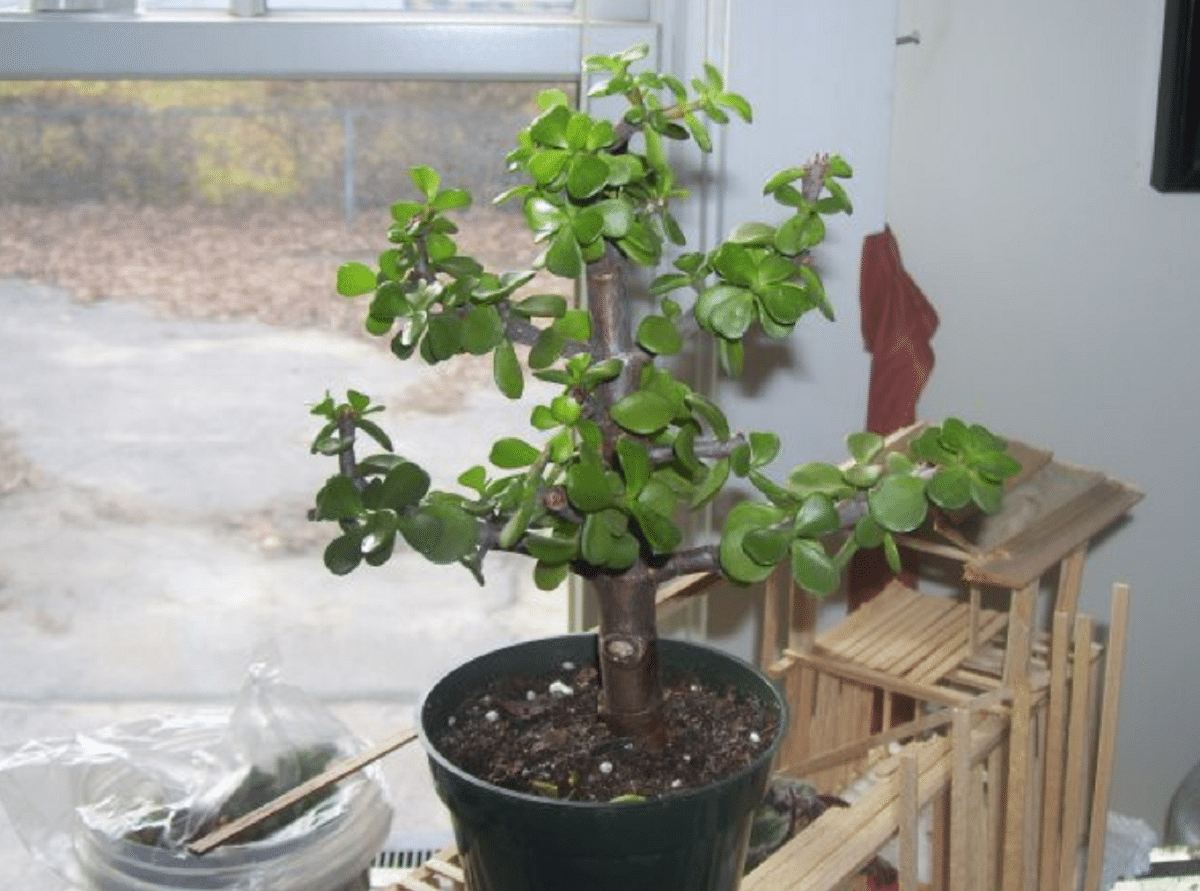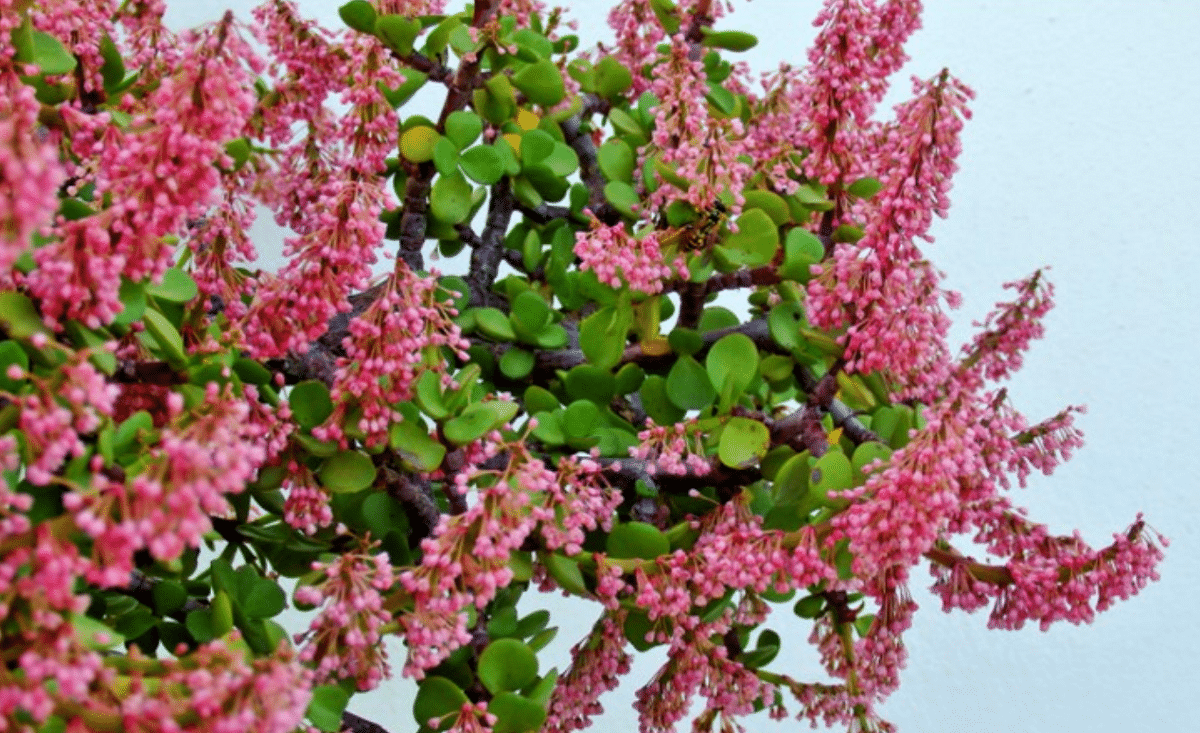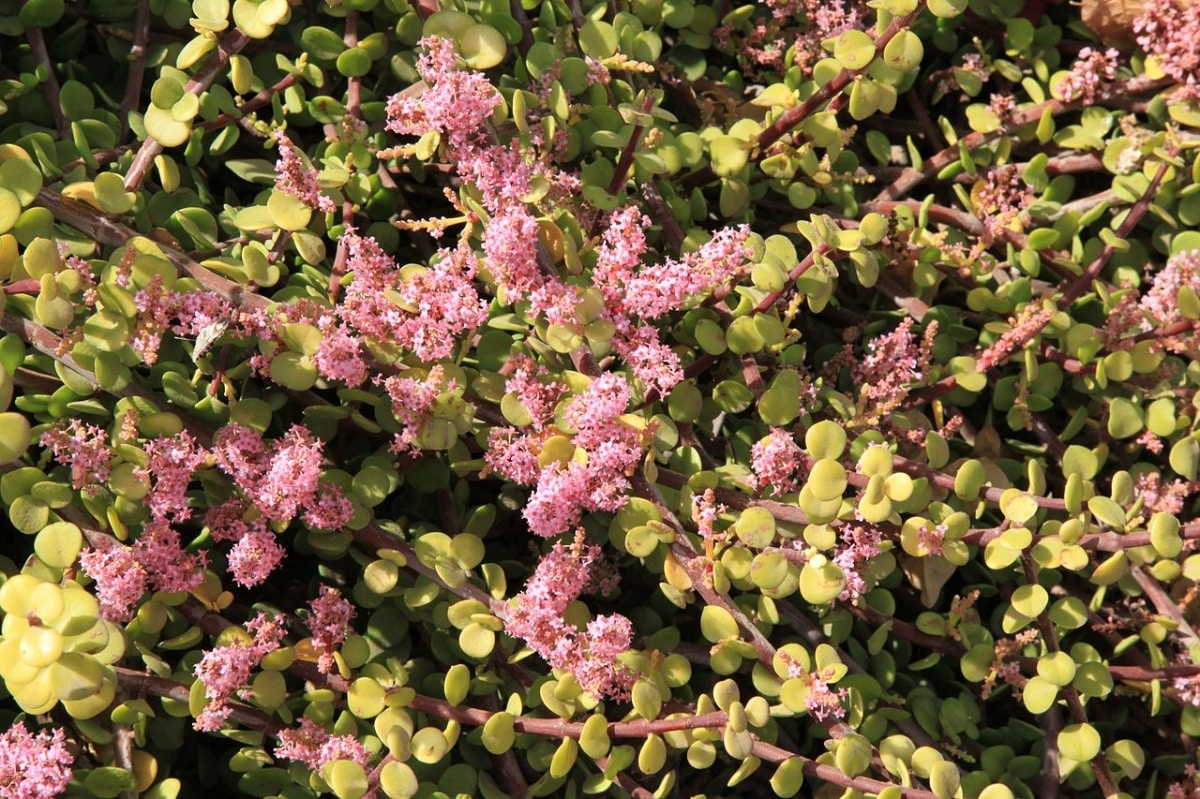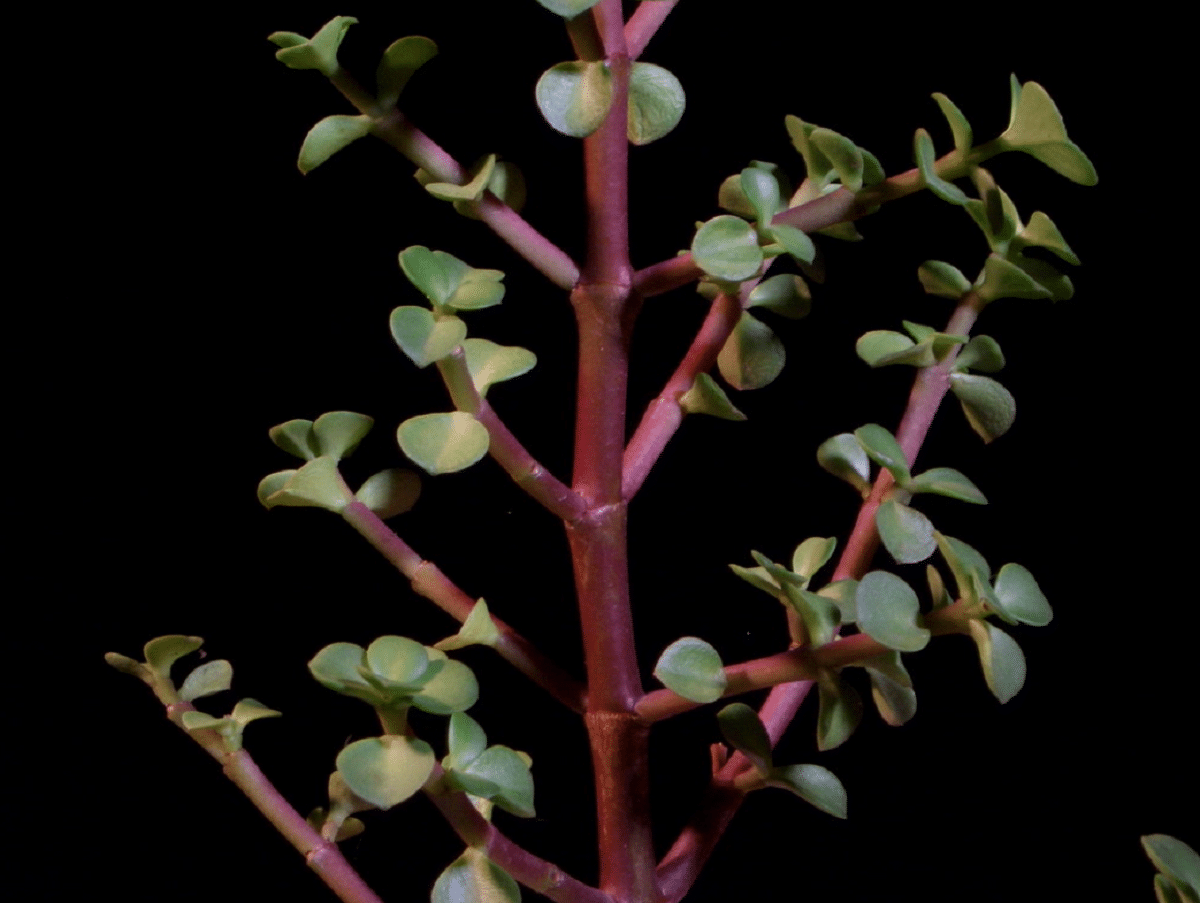
This is a very easy to grow plant that we frequently find in collections of cacti and succulents, as well as in botanical gardens. It is scientifically known by the name of Afra portulaAlthough its popular name may be easier to remember because of how curious it is, since it is called the coin plant.
This pretty succulent shrub is native to southwestern Africa, and it is very easy to care for.
General data of the coin plant

In cultivation it is usually pruned so that it does not exceed 50 cm, there are even those who use it as the first plant for bonsai, since with it you can learn a lot about how and when to prune, and what you get with each cut.
But of course, to have it in good health you have to know what care it requires. Contrary to what it may seem, this is a very easy plant to grow that will give us great satisfaction. So much so that we only need to take into account what we are going to tell you next.
Our protagonist she is a lover of the sun, but if at the moment we do not have any sunny exposition, we will tell you that I have seen magnificent specimens living in semi-shade (yes, they must have more light than shade).
One of its virtues is its ability to withstand long periods of drought if it is planted in the ground.
Features
In order to give this wonderful plant a good life, you have to know it very well. That implies knowing what are their physical characteristics at least. So, some of these most notable are:
It belongs to the Portulacaceae family.
- It is a kind of succulent type, but at the same time it shares the characteristics of a perennial plant.
- The foliage of the plant is a very striking light green color.
- It has the ability to bloom and its flowers are pink.
- It can reach up to 6 meters high, although the height will depend a lot on the taste of each person.
- To be able to plant this species you have to do it during the spring if you want to do it outdoors.
- To be able to plant this species indoors, you can do it at any time of the year.
- The flowering of the plant occurs throughout the spring until the next summer.
- The plant requires direct sun to live, but it can also grow in semi-shady places.
- The width of the plant can reach up to 2 meters if it is not maintained.
how is the flower Afra portula?
The flowers of this plant appear in clusters, and are smallabout a centimeter in diameter. They are pink in color, and sprout from the tops of the branches. Of course, it is important that you know that it is a bit difficult to see the coin plant flourish, but not impossible.
You have to provide it with the care that we have mentioned, but we also recommend fertilizing it with a liquid fertilizer for succulent plants like this one from here.

As you will see, is a lovely plant that has the potential to be a pretty little shrub, as well as a very lush and showy tree. Either way, you can choose one or the other depending on the space you have available, as well as what you have planned for the plant.
Before moving on to the next section I know that you are going to be even more interested, that you know that you can use this plant for hedges, place them in pots or opt for rockery. And as a curious fact, this species has very good adaptability to terrain or areas that are near a beach or the sea.
Caring for the Afra portula

Planting and location
Some people have certain problems with this plant, as there are times when the leaves tend to change color and fall after a few days. Well, this may be because they are not in a place with adequate lighting.
Although it is true that it can live in semi-shade, it will not be able to develop properly since it wants a lot of sun. The more exposed it is to sunlight, the better its leaves will develop and you will notice a great difference in terms of the size of the leaves, than if you place the plant in a semi-shady place.
On the other hand, if your intention is to place it in a pot, do everything possible so that it is not enameled, since you will help the evaporation of moisture and give a better quality of life to the plant.
Lighting design
It is already clear that you can have it outdoors and indoors, right? But remember that the development will not be the same.
Now, assuming the case that you do not have space in the garden or you do not have a space like this, you know that you can have it inside the home. But yes, you have to guarantee a bright light and you have to have it in a place where there are no drafts.
Ideally, you should have it in a window where the glare of sunlight is strong. A curious fact and a A mistake that many people make is to place the plant behind a window or glass doors, so that the glare increases.
This is a terrible mistake that you should avoid at all costs, since this type of light will harm the plant and it will end up charring its leaves. So don't be surprised if you have it in such a place and its leaves are falling off little by little.
The type of substrate
Keep in mind that this species is a succulent type, so the substrate you use should preferably be the same as the one used for cactias this. Now, if you do not have the possibility of acquiring it, you can choose a mixture of sand, vermiculite or failing that, pumice.
And if by chance you do not have the possibility of acquiring any type of these substrates, you do not have to worry, the plant itself has a good adaptability to different terrains And almost any soil you use will do if it doesn't puddle when watering.
But you must make sure that the land has good drainage, since puddles can seriously affect it.
In case you want to have it exposed outdoors and in the sun, try as much as possible to use sandy substrate and not to water too much. And speaking of risks, we move on to the next point.
The watering of the coin plant
This is where most tend to make the biggest maintenance and care mistakes. First of all, during the spring until the fall begins, irrigation has to be moderate and little, that is, you should provide water to the plant approximately every 15 days.
Although this will depend on factors such as humidity, weather conditions and / or the temperature of the environment. If you notice that the soil or substrate of the plant tends to dry out too quickly, we recommend that you water it once or twice a week.
On the other hand, during winter you have to do the exact opposite. This means that the watering must be even more moderate and you will have to wait for the substrate to dry completely before watering the plant again.
For those who have the plant in a pot and have it indoors, know that they will have to make a large hole in the pot at the bottom and remove the plate where the rest of the water falls as this will increase the humidity levels in soil or substrate and can cause roots and leaves to be affected.
You don't need to water every time you notice that the substrate is completely dry during the spring. This for the simple reason that the plant can withstand droughts very well without dying.
In case you do not know if the watering is being excessive or it is not necessary to notice the color of its leaves. If you see that some of its leaves tend to have a blackish color, it is indicative that the humidity is too high and that the plant is beginning to rot.
And something also happens when you are not giving it the necessary watering and this is that the leaves instead of changing color, tend to wrinkle. This is a clear indication that the plant is in need of better hydration.
Now, it may not seem like it, but taking care of this plant is not as complicated as it seems. You should only have it in a place with a lot of sunlight, prune from time to time depending on the level of growth of the plant, provide it with just enough water and have a good substrate with nutrients.
Pests
And if we talk about pests, only you have to control that mealybugs do not appear. If we see any, we will remove them with a cotton swab or with our own hands.
Of the rest, they are minor care that anyone can carry out.
With these tips, you will have a plant that we do not know if it will give you coins, but we can assure you that it will give you many joys.






Good afternoon. I have a portulacaria afra that I have watered too much and the yellow leaves turn and then fall off. That makes it clear to me that I did wrong. But I have another little one made up of 3 cuttings that I planted 1 week ago and I hardly watered it at all until yesterday (a few spray jets). Today I put it in the morning sun for 3 hours and now it has wrinkled leaves. Could the sun cause that or was it that watering today? Thanks greetings
I love that little plant and I recently got 1 specimen and it is very pretty. Thanks to her advice I will keep it better. Greetings from Havana, Cuba.
Thank you Judith 🙂
I want to clarify that the portulacaria is indoors, on a balcony with glass enclosure and receives light all day, and approximately 2 and a half hours of sun. Thanks
Hey.
From what you count, what has happened to it is that the magnifying glass effect has occurred, that is, the sun's rays passing through the glass and hitting the water that you threw on it, have burned the sheet.
Water them underneath or by pouring the water on the ground twice a week and they will be fine 🙂. Of course, if you have a plate under them, remove the water that is left over 15 minutes after watering.
A greeting.
Good afternoon, I have a portulacaria afra, it is in the patio where it receives sunlight, the point is that I do not see that it is so dense and many of its leaves are turning yellow, wrinkled and falling, I would like to know how I do for him to get leafy
Hi Stephanie.
How often do you water it? It is a plant that resists drought well, but it develops better if it is watered 2-3 times a week in summer and once every six days the rest of the year.
A greeting.
Hello, I have a small portulacaria (two stalks). I water it twice a week and it has new leaves in the cup (the upper part). It receives sunlight through a window. The problem is that it loses leaves continuously, they are not dry, nor wrinkled, but they fall continuously. What can it be?
Hello isbael.
Have you ever changed the pot? I ask you because if you have not done it, it may be that I throw away pages due to lack of space.
In any case, it would also be advisable to fertilize it from time to time with a cactus fertilizer (it is not a cactus, but it has similar nutritional needs).
All in all, your plant will still be able to look just as pretty, or more 🙂.
A greeting.
Hello, I would like to know if it is good to put a layer of expanded clay at the bottom of the pot and then put soil and plant a Potulacaria Afra
Hello Antonia.
Yes, it is highly recommended, as this reduces the risk of root rot 🙂
A greeting.
Hello, I have a coin plant that belonged to my mother. It was sunny in the morning until 1 month ago. Now it is on a south facing balcony with no sun and wind. I water it little but the leaves turn yellow and fall.
What I can do? Thanks
Hello, Martha.
The Portulaca needs direct sun to be able to grow; in semi-shade or shade it will not go well
If you can, put it in a brighter area.
A greeting.
Hi! I have a tree of life and I have been for 4 years and always in the same place. I have not changed anything in your care but I noticed that you got brown spots on the leaves. It looks almost like dried mud but if you try to scratch it comes with everything and a piece of blade. Suppose it's some kind of plague but I can't find anything about it. Does anyone know what it is ??
Thank you.
Hi Maely.
I lean more for lack of space. If you have had it for 4 years and you have never changed the pot, it is certain that the soil has already run out of nutrients.
I would recommend transferring it to a somewhat larger pot in spring.
A greeting.
Hello, I have a little plant of the dollar but, I am growing it in water in what month I can move it to the ground now, that they have enough roots, Alejandra greets you
Hi Alejandra.
I recommend planting it in the ground as soon as possible to prevent it from rotting.
A greeting.
Hi Monica I JUST BUY THE COIN, BUT I HAVE IT IN A PLACE WHERE THE SUN DOESN'T GIVE IT MUCH NOW I ASK YOU THE PLANT IS GOING TO DEVELOP WELL AND HOW MANY TIMES A WEEK I SHOULD WATER IT. I WAIT YOUR ANSWER THANK YOU.
Hello Monica.
Ideally, it should be in the sun all day, but I have seen some growing in semi-shade and it was fine.
You have to water it little: twice a week in summer and every 7-10 days the rest of the year.
A greeting.
Hello. I have a portulacaria afra as bonsai and it has many wrinkled leaves and many yellow ones. When I transplanted it, it had green leaves but not like another one that I have that has greener ones. What can I do? Will I stop watering it in a few days? I water it once a week.
Hi Javier.
In principle, at this time a weekly watering is fine. But it is advisable to check the humidity of the soil, for example with a thin wooden stick: if when you remove it it comes out with a lot of attached soil, do not water. And it is not the same climate in Cantabria as in Malaga, for example 🙂, and therefore the frequency of irrigation will not be the same.
Another thing: water the soil, not the plant. If you pour water on the plant it will rot.
A greeting.
My plant has very few leaves and not very green. I would like to know the reason? Thank you
Hello Graciela.
The loss of color and scarcity of leaves is usually due to the lack of light. Therefore, if it is in the shade, it is advisable to take it to a brighter area.
If the sun is out, then write to us again so we can better help you.
Greetings.
The leaves are falling off my plant, which could be
Hello Adminda.
It can be several things. Sight:
-Lack of light: it needs a lot to grow.
-Lack or excess of water: to avoid them, it should be watered when the soil is dry.
Greetings.